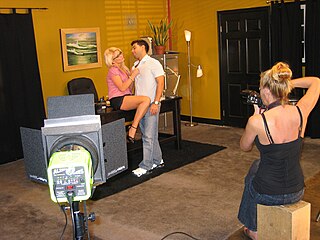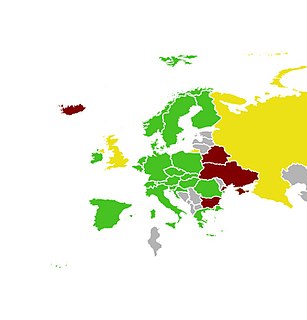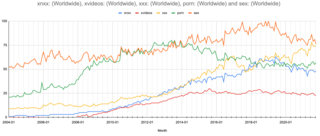Child sex tourism (CST) is tourism for the purpose of engaging in the prostitution of children, which is commercially facilitated child sexual abuse. The definition of child in the United Nations Convention on the Rights of the Child is "every human being below the age of 18 years". Child sex tourism results in both mental and physical consequences for the exploited children, which may include sexually transmitted infections, "drug addiction, pregnancy, malnutrition, social ostracism, and death", according to the State Department of the United States. Child sex tourism, part of the multibillion-dollar global sex tourism industry, is a form of child prostitution within the wider issue of commercial sexual exploitation of children. Child sex tourism victimizes approximately 2 million children around the world. The children who perform as prostitutes in the child sex tourism trade often have been lured or abducted into sexual slavery.

Pornography in the United States has existed since the country's origins and has become more readily accessible in the 21st century. Advanced by technological development, it has gone from a hard-to-find "back alley" item, beginning in 1969 with Blue Movie by Andy Warhol, the Golden Age of Porn (1969–1984) and home video, to being more available in the country and later, starting in the 1990s, readily accessible to nearly anyone with a computer or other device connected to the Internet. The U.S. has no current plans to block explicit content from children and adolescents, as many other countries have planned or proceeded to do.
Internet censorship in Australia is enforced by both the country's criminal law as well as voluntarily enacted by internet service providers. The Australian Communications and Media Authority (ACMA) has the power to enforce content restrictions on Internet content hosted within Australia, and maintain a blocklist of overseas websites which is then provided for use in filtering software. The restrictions focus primarily on child pornography, sexual violence, and other illegal activities, compiled as a result of a consumer complaints process.

Pornography laws by region vary throughout the world. The production and distribution of pornographic films are both activities that are lawful in many, but by no means all countries so long as the pornography features performers aged above a certain age, usually eighteen years. Further restrictions are often placed on such material.

The National Center for Missing & Exploited Children (NCMEC) is a private, nonprofit organization established in 1984 by the United States Congress. In September 2013, the United States House of Representatives, United States Senate, and the President of the United States reauthorized the allocation of $40 million in funding for the National Center for Missing & Exploited Children as part of Missing Children's Assistance Reauthorization Act of 2013. The current chair of the organization is Jon Grosso of Kohls. NCMEC handles cases of missing or exploited children from infancy to young adults through age 20.

Pornography in Europe has been dominated by a few pan-European producers and distributors, the most notable of which is the Private Media Group that successfully claimed the position previously held by Color Climax Corporation in the early 1990s. Most European countries also have local pornography producers, from Portugal to Serbia, who face varying levels of competition with international producers. The legal status of pornography varies widely in Europe; its production and distribution are illegal in countries such as Ukraine, Belarus and Bulgaria, while Hungary is noted for having liberal pornography laws.
Ashcroft v. American Civil Liberties Union, 535 U.S. 564 (2002), followed by 542 U.S. 656 (2004), was a decision of the United States Supreme Court, ruling that the Child Online Protection Act (COPA) was unconstitutional as a violation of the First Amendment's guarantee of freedom of speech.
Internet censorship in the United Kingdom is conducted under a variety of laws, judicial processes, administrative regulations and voluntary arrangements. It is achieved by blocking access to sites as well as the use of laws that criminalise publication or possession of certain types of material. These include English defamation law, the Copyright law of the United Kingdom, regulations against incitement to terrorism and child pornography.
Legal frameworks around fictional pornography depicting minors vary depending on country and nature of the material involved. Laws against production, distribution and consumption of child pornography generally separate images into three categories: real, pseudo, and virtual. Pseudo-photographic child pornography is produced by digitally manipulating non-sexual images of real children to create pornographic material. Virtual child pornography depicts purely-fictional characters. "Fictional pornography depicting minors", as covered in this article, includes these latter two categories, whose legalities vary by jurisdiction, and often differ with each other and with the legality of real child pornography.

Internet pornography is any pornography that is accessible over the internet, primarily via websites, FTP servers peer-to-peer file sharing, or Usenet newsgroups. The availability of widespread public access to the World Wide Web in late 1990s led to the growth of internet pornography.
An obscenity is any utterance or act that strongly offends the prevalent morality of the time. It is derived from the Latin obscēnus, obscaenus, "boding ill; disgusting; indecent", of uncertain etymology. Such loaded language can be used to indicate strong moral repugnance and outrage, in expressions such as "obscene profits" and "the obscenity of war". As a legal term, it usually refers to graphic depictions of people engaged in sexual and excretory activity, and related utterances of profane speech.
Child pornography laws in the United States specify that child pornography is illegal under federal law and in all states and is punishable by up to 20 years' imprisonment or a fine of $5000. The Supreme Court of the United States has found child pornography to be outside the protections of the First Amendment to the United States Constitution. Federal sentencing guidelines on child pornography differentiate between production, distribution, and purchasing/receiving, and also include variations in severity based on the age of the child involved in the materials, with significant increases in penalties when the offense involves a prepubescent child or a child under the age of 12. U.S. law distinguishes between pornographic images of an actual minor, realistic images that are not of an actual minor, and non-realistic images such as drawings. The latter two categories are legally protected unless found to be obscene, whereas the first does not require a finding of obscenity.
The production, sale, distribution, and commercialization of child pornography in Japan is illegal under the Act on Punishment of Activities Relating to Child Prostitution and Child Pornography, and the Protection of Children (1999), and is punishable by a maximum penalty of five years in prison and/or a fine of ¥5,000,000. Simple possession of child pornography was made illegal by an amendment to the act in 2014. Virtual child pornography, which depicts wholly-fictional characters, is legal to produce and possess.
Child pornography is illegal in most countries, but there is substantial variation in definitions, categories, penalties, and interpretations of laws. Differences include the definition of "child" under the laws, which can vary with the age of sexual consent; the definition of "child pornography" itself, for example on the basis of medium or degree of reality; and which actions are criminal. Laws surrounding fictional child pornography are a major source of variation between jurisdictions; some maintain distinctions in legality between real and fictive pornography depicting minors, while others regulate fictive material under general laws against child pornography.
Child pornography is pornography that unlawfully exploits children for sexual stimulation. It may be produced with the direct involvement or sexual assault of a child or it may be simulated child pornography. Abuse of the child occurs during the sexual acts or lascivious exhibitions of genitals or pubic areas which are recorded in the production of child pornography. Child pornography may use a variety of mediums, including writings, magazines, photos, sculpture, drawing, painting, animation, sound recording, video, and video games. Child pornography may be created for profit or other reasons.
Pornography in the Philippines is not specifically defined in Philippine law, but the Revised Penal Code of the Philippines considers certain acts to be obscene or indecent and these are prohibited as immoral doctrines, obscene publications, indecent shows, or other similar material or portrayals that advocate human immorality, obscenity, and indecency. Philippine legislation penalizes participation in these unlawful activities, and Republic Act No. 7610 extends punishment to those involved in child abuse, child exploitation, child prostitution and discrimination of children.
Internet censorship in South Africa is a developing topic.

Pornography in Asia is pornography created in Asia, watched in Asia, or consumed or displayed in other parts of the world as one or more genres of Asian porn.

Pornography in Bangladesh is forbidden. It is against the law to watch, produce, distribute, or possess pornography, since the Pornography Control Act has been passed in 2012.

Pornography in Albania is restricted. It is only illegal for producing, delivering, advertising, importing, selling and publishing pornographic material under the age of 18. Child pornography is prohibited, but Albania has failed to adopt laws against the publishing, manufacturing, accessing, dissemination and the expansion of child pornography. Internet pornography is legal.






